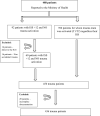Evaluation of activation criteria in paediatric multi-trauma
- PMID: 36865755
- PMCID: PMC9971577
- DOI: 10.1093/pch/pxac085
Evaluation of activation criteria in paediatric multi-trauma
Abstract
Objective: To explore the optimal set of trauma activation criteria predicting paediatric patients' need for acute care following multi-trauma, with particular attention to Glasgow Coma Scale (GCS) cut-off value.
Methods: A retrospective cohort study of paediatric multi-trauma patients aged 0 to 16 years, performed at a Level 1 paediatric trauma centre. Trauma activation criteria and GCS levels were examined with respect to patients' need for acute care, defined as: direct to operating room disposition, intensive care unit admission, need for acute interventions in the trauma room, or in-hospital death.
Results: We enrolled 436 patients (median age 8.0 years). The following predicted need for acute care: GCS <14 (adjusted odds ratio [aOR] 23.0, 95% confidence interval [CI]: 11.5 to 45.9, P < 0.001), hemodynamic instability: (aOR 3.7, 95% CI: 1.2-8.1, P = 0.01), open pneumothorax/flail chest (aOR: 20.0, 95% CI: 4.0 to 98.7, P < 0.001), spinal cord injury (aOR 15.4, 95% CI; 2.4 to 97.1, P = 0.003), blood transfusion at the referring hospital (aOR: 7.7, 95% CI: 1.3 to 44.2, P = 0.02) and GSW to the chest, abdomen, neck, or proximal extremities (aOR 11.0, 95% CI; 1.7 to 70.8, P = 0.01). Using these activation criteria would have decreased over- triage by 10.7%, from 49.1% to 37.2% and under-triage by 1.3%, from 4.7% to 3.5%, in our cohort of patients.
Conclusions: Using GCS<14, hemodynamic instability, open pneumothorax/flail chest, spinal cord injury, blood transfusion at the referring hospital, and GSW to the chest, abdomen, neck of proximal extremities, as T1 activation criteria could decrease over- and under-triage rates. Prospective studies are needed to validate the optimal set of activation criteria in paediatric patients.
Keywords: Activation criteria; Acute care; Children; Glasgow Coma Scale; Multi-trauma.
© The Author(s) 2022. Published by Oxford University Press on behalf of the Canadian Paediatric Society. All rights reserved. For permissions, please e-mail: journals.permissions@oup.com.
Figures
References
-
- National Center for Health Statistics. Health, United States, 2015: With Special Feature on Racial and Ethnic Health Disparities. Hyattsville, MD; Washington, DC: US Department of Health and Human Services, 2016; http://www.cdc.gov/nchs/data/hus/hus15.pdf. Accessed January 19, 2021. - PubMed
-
- Peden M, Oyegbite K, Ozanne-Smith J, et al. . World report on child injury prevention. Geneva: World Health Organization; 2009. - PubMed
-
- Heron M, Sutton PD, Xu J, Ventura SJ, et al. . Annual summary of vital statistics: 2007. Pediatrics. 2010;125:4–15. - PubMed
-
- Williams D, Foglia R, Megison S, et al. . Trauma activation: Are we making the right call? A 3-year experience at a Level I pediatric trauma center. J Pediatr Surg 2011;46:1985–91. - PubMed
LinkOut - more resources
Full Text Sources


